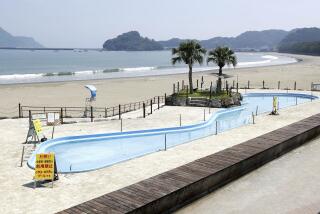Japan’s prime minister visits earthquake, tsunami zone
Japanese Prime Minister Naoto Kan on Saturday visited tsunami survivors and workers trying to bring the Fukushima nuclear facility under control as the plant’s operator said highly radioactive water was leaking from a pit near a reactor into the ocean.
Kan was briefed by city officials in the northern city of Rikuzentakata and later met with 250 disaster victims at a school. “I promise that the government will fully assist survivors to regain a normal life,” Kan, dressed in a blue workman’s-style jacket and pants, told reporters at the school.
Afterward, he flew by helicopter to the base camp where the Fukushima Daiichi triage operations were being coordinated, and offered words of thanks and encouragement to Japanese troops and employees of Tokyo Electric Power Co.
Tepco said it had detected an 8-inch crack in the concrete pit holding power cables near reactor No. 2 and was working to seal the fracture. Tepco said the water was coming directly from the reactor and the radiation level was 1,000 millisieverts an hour. The annual limit of radiation exposure allowed for Fukushima workers is 250 millisieverts.
After spraying thousands of tons of water on the reactors at Fukushima over the last three weeks to keep the facility from overheating and releasing dangerous amounts of radiation over a wide area, the utility is faced with the problem of great volumes of contaminated water.
With storage tanks at the facility nearing capacity, Tepco is contemplating storing the water in a giant artificial floating island offshore, Kyodo news reported. Tepco, which has been monitoring radiation levels in seawater just offshore from the plant, said it would begin sampling about nine miles off the coast.
As 25,000 Japanese and U.S. forces continued an intensive search for corpses along the tsunami-battered coastline of northern Japan, the official death toll climbed to 11,938 and the number of missing fell to 15,748, the National Police Agency said.
The number of people still taking refuge in emergency shelters has declined to about 165,000 from more than 200,000 in the days immediately after the quake and tsunami March 11. But concerns are growing about the health of elderly evacuees at the shelters, some of which still lack enough kerosene to run heaters round-the-clock. Many areas of northern Japan are still experiencing subfreezing temperatures.
An NHK broadcast Saturday detailed the deaths of some elderly evacuees and cataloged harsh conditions facing aged survivors of the disaster, including crowded quarters, interruptions in the normal regimens of medicine and a discontinuation of services such as physical therapy.
In a bit of good news, NHK reported that coast guard officers had found a dog on the roof of a house floating in waters off Miyagi prefecture. The dog, which apparently had been stranded for three weeks, was emaciated and gobbled down sausages and cookies after being saved.
julie.makinen@latimes.com
More to Read
Sign up for Essential California
The most important California stories and recommendations in your inbox every morning.
You may occasionally receive promotional content from the Los Angeles Times.











